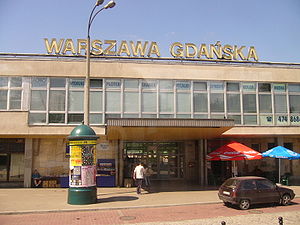- Warszawa Gdańska station
-
Warszawa Gdańska
 Railway Station
Railway StationStation statistics Coordinates 52°15′31″N 20°59′41″E / 52.25861°N 20.99472°ECoordinates: 52°15′31″N 20°59′41″E / 52.25861°N 20.99472°E Lines Route 20
(Warszawa Główna Towarowa - Warszawa Praga)
Route 509
(Warszawa Główna Towarowa - Warszawa Gdańska)Structure Ground level Platforms 3 Tracks 5 Other information Opened 1880 Rebuilt 1920, 1948, 1958-1959, 1984 Owned by Polish State Railways SA Formerly Vistulan Main Train Station
(Polish: Główny Dworzec Kolei Nadwiślańskiej)Traffic PKP Category B Station Location 
Warszawa Gdańska station (also known as Dworzec Gdański; literally Gdańsk station in Warsaw) is a railway station in northern Warsaw, Poland.
It is located on the "Northern Line" that runs between Central Warsaw and the city's Żoliborz district to the north. It serves as a transportation hub for regional trains departing the station. It connects with the Warsaw Metro's Dworzec Gdański stop, located below the railway station, and a number of nearby tram and bus stops.The Warsaw Metro has received EU funding to build a pedestrian tunnel linking the metro station to the railway station.
The railway station is located some 3.5 km north of the main rail line crossing the city linking Warszawa Wschodnia, Warszawa Centralna and Warszawa Zachodnia railway stations and as such is sometimes used as a reserve station, used by trains during track works on the main line, but that is quite rare, as there are two tracks in each direction on the main line.
Currently (2011), it is used exclusively by Koleje Mazowieckie for services KM9 to/from Ciechanów and Działdowo via Legionowo, Modlin, Nasielsk, where the train changes number, Mława and Iława (the latter two only for trains continue to Działdowo, from/to starting/terminating at Warszawa Wola. Trains continuing to Działdowo, wait in Ciechanów for 50 minutes. Some trains terminate at Legionowo and Modlin.
History
The original station was built around 1880 under the name of Vistulan Main Train Station (Polish: Główny Dworzec Kolei Nadwiślańskiej) and served a local line running along the Vistula river northwards. In early 20th century, with the opening of a railway bridge over the river south of Warsaw Citadel (directly to the east of the station; the bridge was constructed around 1870, but was initially used by the Russian Army exclusively), it was renamed Warszawa Kowelska (Warsaw Kovel train station) and started serving as a junction between the Warsaw Główna and Warszawa Wileńska stations located in downtown Warsaw and downtown Praga (respectively). Until then the passengers travelling from St. Petersburg to Vienna had to leave the train station at Warszawa Wileńska, take a tram to the city centre and take another train of the European standard gauge (1435 mm) Warsaw-Vienna railway running from there. The Warsaw Kovel station also served as the main supply station for the Russian garrison stationed in the Warsaw Citadel.
During the withdrawal of Russian troops from Warsaw in August 1915, the station was demolished, along with the bridge to which it led. After World War I both were rebuilt, and the station was renamed Warszawa Gdańska (Warsaw Gdańsk station), the name being coined after the city of Gdańsk.
After 1933, with the opening of the cross-city line, linking three main Warsaw train stations, the Warsaw Gdańsk station lost its importance as a transit station and began serving as a station for local and suburban trains.
After 1942, a western part (adjacent to the Warsaw Ghetto) of the freight station of the Warszawa Gdańska has been adapted to become the Umschlagplatz (collection point) — the deportation facility for Warsaw's Jews.
After World War II, due to the complete destruction of many Warsaw's railway stations, Warsaw Gdańsk was used as a temporary station for long-distance trains, including, until the 1970s, trains passing through Warsaw between the USSR and the west. Among the notable trains to stop there was the Ost-West Express from Moscow to Ostend, Hoek van Holland and Paris, the Chopin to Vienna, and the Praha to Prague. As such, it was the main location through which people expelled in the aftermath of the Polish 1968 political crisis left Poland. The events of 1968 are now commemorated by a stone tablet on the station's platform.
Between 1958-1959 the new building of the station was constructed. It was the first station built in Warsaw after World War II, and it was at the time the most modern station in Warsaw. The building stood until 1984, when it was destroyed in a fire. The station was rebuilt in a few years with some changes (i.e. a new story was added).
In the 1970s, the station's long-distance services were completely taken over by the newly-built Warszawa Centralna, and Warszawa Gdańska became a minor station for suburban trains.
External links
 Media related to Warszawa Gdańska railway station at Wikimedia Commons
Media related to Warszawa Gdańska railway station at Wikimedia Commons- Vintage train at the station
- Modern view of the neglected part of the station
- Warszawa Kowelska on an old postcard (pre-1915)
Preceding station Koleje Mazowieckie Following station Warszawa Kołotoward Warszawa WolaKM9 Warszawa ZOOtoward DziałdowoPreceding station Szybka Kolej Miejska (Warsaw) Following station Terminus S9 Warszawa ZOOtoward WieliszewCategories:- Railway stations in Warsaw
- Railway stations opened in 1880
- Railway stations served by Koleje Mazowieckie
- Railway stations served by Szybka Kolej Miejska (Warsaw)
Wikimedia Foundation. 2010.


